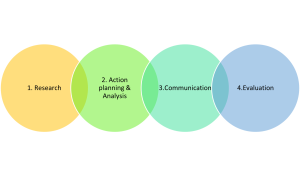15 Strategic Public Relations Planning

The process of strategic public relations planning is essentially built in four stages. Although there are several variations around how to label and describe these stages, the first step in the process is always research. The middle stages of the process address the functions of analyzing the data gathered during the research stage, and then enacting the decisions made based on that data through communication, tactics, and implementation of the plan. And the final stage of the process is always evaluation. The three most commonly known acronyms used to describe these planning processes include John Marston’s (1963) RACE formula (research, action, communication, evaluation); Jerry Hendrix’s ROPE process (research, objectives, programming, evaluation); and Professor Sheila Clough Crifasi’s model, ROSIE[1] – (Research Objectives Strategy Implementation Evaluation). All of these acronyms cover essentially the same key elements, however, in this course we will focus on the RACE formula with a slight addition. Our RACE formula will include Research, Action planning & Analysis, Communication, Evaluation, as this is now the most commonly used acronym in the Canadian public relations industry. In fact, candidates for accreditation through CPRS (the Canadian Public Relations Society) are required to use RACE in their exam answers, as well as their communication work-sample submissions. You will find the RACE formula is very well recognized, and it will help you to focus on the complete public relations process without skipping any important steps.

Stage 1. RESEARCH the current environment and gather information for decision making and analysis of problems and opportunities.
Stage 2. ANALYZE the data gathered in stage 1 to determine appropriate goals, objectives and publics.
Stage 3. COMMUNICATE the program objectives established in stage 2 through the use of tactics and strategies.
Stage 4. EVALUATE the success of the plan by measuring how effectively the objectives were met.
Reference
Marston, J. E. (1963). The nature of public relations. New York: McGraw-Hill.
- Developed by Professor Sheila Clough Crifasi and subsequently featured in the seventh edition of Fraser Seitel's textbook, The Practice of Public Relations ↵
A goal is something that a person or group is trying to achieve.
An objective is a goal expressed in specific terms.
Any group(s) of people held together by a common interest. They differ from audiences in that they often self-organize and do not have to attune to messages; publics differ from stakeholders in that they do not necessarily have a financial stake tying them to specific goals or consequences of the organization. Targeted audiences, on the other hand, are publics who receive a specifically targeted message that is tailored to their interests.
Tactics are the activities that you will implement to carry out each strategy. They are the day-to-day steps that will move the organization forward towards reaching its overall objectives.
A plan of action or policy designed to achieve a major or overall aim

